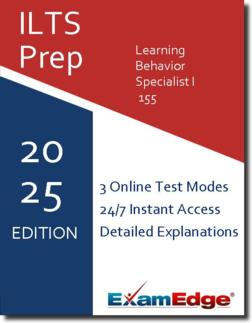ILTS Learning Behavior Specialist I (155) Practice Tests & Test Prep by Exam Edge - Topics
Based on 40 Reviews
- Real Exam Simulation: Timed questions and matching content build comfort for your ILTS Learning Behavior Specialist I - 155 test day.
- Instant, 24/7 Access: Web-based ILTS Learning Behavior Specialist I - 155 practice exams with no software needed.
- Clear Explanations: Step-by-step answers and explanations for your ILTS exam to strengthen understanding.
- Boosted Confidence: Reduces anxiety and improves test-taking skills to ace your ILTS Learning Behavior Specialist I - 155 (155).

Understanding the exact breakdown of the ILTS Learning Behavior Specialist I - 155 test will help you know what to expect and how to most effectively prepare. The ILTS Learning Behavior Specialist I - 155 has multiple-choice questions The exam will be broken down into the sections below:
| ILTS Learning Behavior Specialist I - 155 Exam Blueprint | ||
|---|---|---|
| Domain Name | ||
| Foundations and Characteristics | ||
| Assessing Students and Developing Individualized Programs | ||
| Planning and Delivering Instruction | ||
| Managing the Learning Environment and Promoting Students' Social Interaction and Communication Skills | ||
| Working in a Collaborative Learning Community | ||
| Professional Conduct, Leadership, and Growth |


